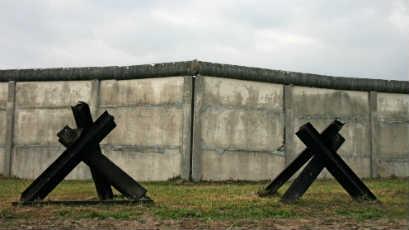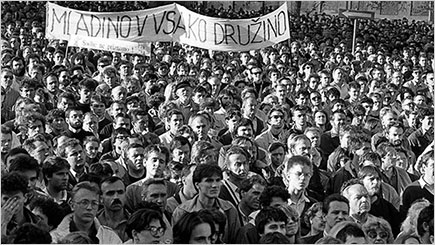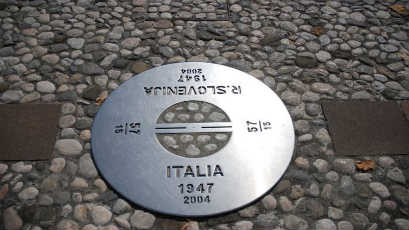Asset Publisher

Travels beyond the Iron Curtain
1987-1988
Bruno HALLER

As part of the “Ostpolitik” introduced by the German Chairmanship of the Committee of Ministers in April 1985, the Secretary General was instructed “to ascertain and propose areas where it would be possible to engage in closer co-operation with those states of Europe that are neither members of the Council of Europe nor parties to the European Cultural Convention”, it being implicitly understood that he would visit the countries concerned to discuss the matter face to face with the relevant authorities.
Official visits were accordingly arranged to Hungary (18-21 June 1987), Poland (9-12 March 1988) and Yugoslavia (1-2 November 1988). A visit to Czechoslovakia was also planned but had to be delayed because of the tensions between the country’s authorities and their opponents – including the famous Charter 77 Movement headed by Václav Havel – which led to the downfall of the regime during the Velvet Revolution at the end of 1989. As initial steps that heralded the future enlargement of the Organisation, these visits were highly informative and gave us insights into issues which came up again subsequently during the accession procedures.
Budapest: a bridge between East and West Foreign Minister Genscher had suggested that we contact the Hungarian Academy of Sciences in Budapest, which the authorities had often used for contacts with western Europe. The Austrian Ambassador, Hans Knitel, who had been appointed to Strasbourg in January 1985 and had played a very active part in the plans to open up the Council of Europe to eastern Europe, gave us the relevant practical information. The upshot was an invitation issued by the Academy of Sciences to Marcelino Oreja to visit Budapest and give a speech during a solemn ceremony. The Academy also took charge of co-ordinating the programme of talks with the Hungarian authorities, at the Ministry for Foreign Affairs and the Ministry for Culture and Education. In addition, there were informal contacts with the People’s Patriotic Front, which I arranged directly.
Marcelino Oreja: “Hungary, a swallow heralding a new spring”
The day after our arrival in Budapest, we received a warm welcome from the President of the Academy, Iván Berend, in its beautiful neo-Renaissance building that is home to many splendid statues, including those of Newton, Galileo, Descartes and Leibniz, and was bathed in lovely summer sunshine. The theme of the speech given on 19 June 1987 to a full auditorium of very attentive participants, made up of members of the Academy and representatives of official institutions, was “European Cultural Identity and Protection of the European Cultural Heritage”, divided into three parts: existence of a broadly common history and heritage; facing up to common challenges; and the need for awareness of a common future.
The Secretary General underlined the Council of Europe’s openness and desire for co-operation, as well as its particular task of promoting pluralist democracy, the rule of law and the protection of human rights and freedoms. The audience was particularly appreciative of the following statement: “Eastern Europe is a mosaic, not a bloc. The Hungarians were among the first to recognise the importance of the new ideas through their historically intense attachment to Europe. Even when times were hardest, Hungary was eager to maintain relations with the Council of Europe. At present, it is the only country to manifest that intention, like the first swallow heralding imminent change.”
The subsequent meetings with the authorities confirmed that the speech had gone down well with them, too, as demonstrated by unequivocal comments such as: “Relations between the two parts of Europe depend too much on relations between the Soviet Union and the United States: if they were more balanced they could possibly improve relations between the two superpowers”; “the Council of Europe was previously seen in the East as an instrument of the Cold War, but it is currently showing greater openness: Hungary wishes to take advantage of this to join its multilateral framework and develop closer relations with its member countries”.
Gyula Horn: “Our ‘White House’ must reform and open up to the changes demanded by society”
At the Ministry for Foreign Affairs, we had separate talks with the minister, Péter Várkonyi, and the State Secretary, Gyula Horn, who was more open to dialogue and was quite frank in expressing his opinions. After the introductory greetings, he took us to the window of his office and said: “We have a ‘White House’ in Budapest. It is opposite us here. It is the party headquarters. It must reform and open up to the changes demanded by society so that we can prepare our accession to the Council of Europe.” During the discussions, he underlined his country’s commitment to the Helsinki Final Act follow-up process and referred to his good relations with the German and Austrian Ministers for Foreign Affairs, Hans-Dietrich Genscher and Aloïs Mock, with whom he conferred regularly. He seemed to be one of the reformers most determined to change the political system in his country and he did go on to play a key role in the peaceful and negotiated democratic transition there.
At the Ministry for Culture and Education, we were received by the minister, Mr Köpeczi. He told the Secretary General that it was the concept of European cultural identity developed by the Council which had been largely responsible for Hungary’s positive attitude during the discussions at the Cultural Forum held shortly beforehand in Budapest and which had led his country to support 80% of the proposals made by west European countries. He wanted practical co-operation projects to develop swiftly with the Council and gave several examples of activities in the sectors for which he was responsible: in particular, culture, education and youth.
There was also an interesting meeting with the Minister for Trade, Tamás Beck, who did not hide his country’s catastrophic economic and financial situation, with foreign debt of some US$20 billion and around 50 badly managed, loss-making big companies to be sold off. However, he believed in Hungary’s ability to recover, in particular by drawing on small and medium-sized enterprises that had survived collectivisation and maintained relations with similar companies in neighbouring countries in the West. All the same, several billion dollars of foreign investment would be needed to revive key sectors and avoid mass unemployment of a kind that would be unbearable for the population. He referred to ongoing contacts with the European Community with a view to the conclusion of an economic agreement.
A positive assessment and effective follow-up
We gained a very good impression from the visit, which clearly demonstrated the authorities’ willingness to co-operate with the Council and, having taken place at the right time, set a process of rapprochement in motion.
A delegation of senior officials from Hungary visited Strasbourg a few months later, on 12 and 13 October 1987. Meetings were arranged with the operational directorates concerned (culture, education, youth, environment, local authorities, health and legal co-operation) and, with our Hungarian guests, we reviewed all the activities that might be of interest to them. Several co-operation projects were outlined in the areas of education, culture and youth, and implemented without delay. This was much appreciated by our new partners.
Gyula Horn visited Strasbourg on 2 and 3 May 1988 to meet the Secretary General and discuss with him the requirements to be met for joining the Council and the reforms that would have to be carried out or started beforehand to that end. The meeting between the two men was very cordial and the minister began by telling the Secretary General how greatly his speech at the Academy of Sciences had been appreciated. He did not hide the fact that he himself had been very touched by the poetic metaphor describing Hungary as “the first swallow heralding imminent change in eastern Europe”.
He then gave a very substantial talk at a joint meeting of two Assembly committees, namely those on political affairs and on relations with European non-member countries. He made very encouraging comments on “safeguarding and expanding human rights as the most important criterion of humanism and democracy” and on “the common cultural heritage which is one of the key ties between the nations of Europe”. The visit also gave me an opportunity to establish a personal relationship and, during a dinner with a small group of guests in a local restaurant, I got to know a warm, courteous and open man who was very thoughtful and measured with his comments but was clearly convinced that his country’s future lay in Europe.
Things start to move in Hungary
The context was favourable because things had started to move at the highest level in Hungary. At the Congress of the Hungarian Socialist Workers’ Party, Károly Grósz had replaced János Kádár as party general secretary. He was a cautious reformer who came out in favour of a gradual transition from a one-party system to a multiparty system and who prompted practical measures which gave the population more rights and freedoms.
For instance, as from 1 January 1988, all Hungarians had been able to apply for passports to travel to any country in the world, and hundreds of thousands of people had immediately seized the opportunity. As from 1 January 1989, they were granted the freedom to travel visa-free to Vienna, where they could do their shopping. The multiparty principle was accepted in February.
For his part, Gyula Horn, who had been appointed Minister for Foreign Affairs, entered into negotiations with the Kremlin, which proved successful, with him being able to announce in April that the Soviet Union had agreed to withdraw its troops in 1991.
On 27 June, he met Aloïs Mock at the Austro-Hungarian border and together they cut through the barbed wire of the Iron Curtain in the presence of large numbers of journalists. It was a highly symbolic event and the photos spread around the world like wildfire. Thousands of East Germans took advantage of this by taking the route through Hungary to seek refuge in the West: this first breach made by the two ministers heralded the fall of the Berlin Wall which followed in November.
If you wish to continue your reading, you may buy the book "Europe: a human enterprise".
Bruno HALLER
Bruno Haller joined the Council of Europe in 1972 as Deputy Director of the European Youth Centre (EYC). In 1980 he became head of the Plan and Programme Division before returning to the EYC as Director. In October 1984 he was appointed Director of the Private Office of the new Secretary General, Marcelino Oreja. In January 1989, he was appointed Deputy Clerk of the Parliamentary Assembly, before being elected Secretary General of the Assembly in September 1995, a position he held until his retirement in 2006.




